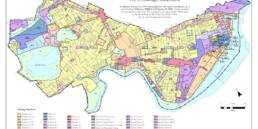As architects and designers, we strive to create spaces that not only serve practical needs but also inspire and uplift. While its primary function is academic, we can dissect the approach to the design of The Bloomberg Center and uncover residential design secrets that can transform your project.
This blog will explore three pivotal design strategies employed at the Bloomberg Center that can elevate your home. From harnessing the power of natural light to fostering community through thoughtful spaces and integrating art into the design, these principles reveal how architecture can enhance functionality and emotional well-being. Join us as we delve into these design residential design secrets and discover how to apply them to your own living spaces.
Secret #1: Leverage Natural Light
Exposure to natural light offers numerous benefits, from enhancing mood and well-being to improving energy efficiency. Natural light helps regulate circadian rhythms, leading to better sleep and reduced stress levels. It creates a more pleasant and stimulating environment, boosting productivity and happiness. Integrating natural light into building designs can also significantly reduce reliance on artificial lighting, lowering energy consumption, cutting operational costs, and promoting sustainability.
At the Bloomberg Center, the architects strategically designed the building with larger windows and a central atrium to maximize natural light. This thoughtful design not only enhances energy efficiency by reducing the need for artificial lighting but also makes the interior feel more inviting and open. The atrium’s abundant natural light improves occupant’s well-being and contributes to the building’s overall ambiance, but that’s not all. The atrium also plays a large part in Secret #2.
Secret #2: Encourage informal gatherings and collaboration
The Atrium at the Bloomberg Center is part light well, stair, and meeting space. The “Room Stair,” a cascading stairway situated within the atrium, functions not only as a means of vertical circulation but also as a space for sitting, meeting, and engaging in spontaneous conversations. It is a combination of practical and social functions and the spaces it supports integrate seamlessly with the surrounding spaces. An informal space at the base of the Atrium, “The Beach,” offers a versatile place where individuals are invited to relax, meet, and engage in conversations outside the formal classroom setting. This intentional blend of open, flexible areas and structured yet inviting architectural elements promotes a sense of community and encourages the exchange of ideas.
The same principles implemented at the Bloomberg Center can be applied to your home design. Design can help encourage informal gatherings and promote communication. This can be huge for families with children, especially as they grow older. These informal interactions have been proven to build stronger bonds, improve communication, and enhance creativity. Couldn’t we all use a little more of that in our lives?
Secret #3: Integrate Art in the Design
Art is all too often left as an afterthought in design. At the Bloomberg Center, it was not. While much of the credit belongs to the artists whose pieces are permanently installed here, an integrated process enhances art’s ability to complement architecture in creating a sense of place. Art is well known for its ability to foster engagement, enrich the environment, and emotionally impact those around it. While we don’t profess to be art experts, we encourage you to consider art in the design process, whether you are wealthy enough to have an art consultant or want to hang photos of your family and the good times you’ve shared.
After exploring the design strategies implemented at the Bloomberg Center and unlocking these residential design secrets, we can utilize them to enhance your residential project. These strategies not only enhance aesthetic appeal but also promote well-being, social connectivity, and creativity. As you embark on your residential design journey, consider how these principles can be adapted to create spaces that inspire, nurture, and uplift. Architecture is more than just constructing buildings—it’s about crafting environments that resonate with the people who live within them.
We want to open that world to you. Contact us today about our Exploration Consultation. We’re happy to work with you wherever you are in the process. Together, we can craft a living environment that truly resonates with you and your family.



















